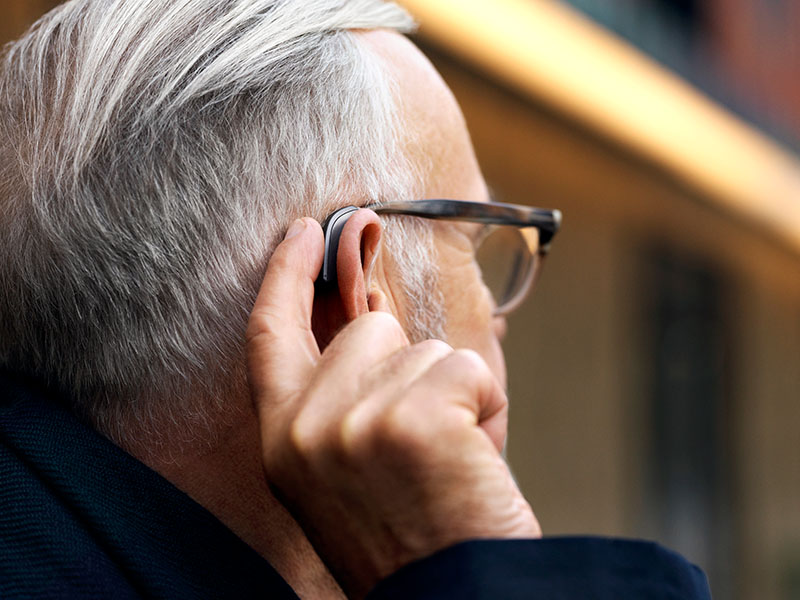Nothing’s better than the pure delight of crisp, crystal-clear sounds enveloping your senses. Yet, as time changes your hearing, you question whether it’s time for a hearing aid upgrade. Now, the real question is, how do you know which hearing aid will best fit your needs? Read on to learn the pros and cons of in-the-ear (ITE) hearing aids and behind-the-ear (BTE) hearings.
How do hearing aids work?
Hearing aids use three core components to amplify sounds from your surroundings and into your ear. These three components are the microphone, speaker, and amplifier.
- The microphone is responsible for gathering sounds, which are transformed into digital code by a computer chip equipped with an amplifier.
- Once amplified, the signals are reconverted into sound waves and sent to your ears through specialized speakers, a.k.a. receivers.
This intricate process ensures your hearing experience is optimized to your unique needs. Now, let’s take a look at the detailed difference between ITE and BTE hearing aids.
ITE (in-the-ear) hearing aids
ITE hearing aids are a popular choice for anyone looking for discreet and convenient assistance. These devices are made to fit right inside the ear, offering various benefits and enhancements for users.
Pros of ITE hearing aids:
- Cosmetic appeal: ITE hearing aids are custom-made to fit your ear making them subtle and less noticeable when worn (similar to wearing an earphone).
- Ease of use: The larger sized ITE devices allow for user-friendly controls and battery changes, making them suitable for users with agility issues.
- Sound quality: ITE hearing aids have more advanced technology due to their bigger size, giving users superior sound quality and features.
- Less wind noise: Since the position of the hearing aid is inside of your ear, it reduces the impact of wind noise whenever you’re outside.
- Phone compatibility: Some ITE models are made with telecoil technology which transmits an audio signal directly into the hearing aid, enhancing call clarity and reducing background noise.
Cons of ITE hearing aids:
- Visibility: Although they are hidden, ITE hearing aids may still be partially visible in your ear.
- Comfort and fit: Getting the perfect size and fit may require precise molding. Some wearers may also feel having something inside their ear is too uncomfortable or itchy.
- Battery life: Even the larger versions of the ITE hearing aids may still have a small battery size leading to shorter battery life.
- Limited features: Their size may also impact the features that come available with larger behind-the-ear hearing aids.
In short, in-the-ear hearing aids provide a natural, hidden look, user-friendly controls, and potential sound quality benefits. However, you’ll need to consider the fit, comfort, and feedback concerns when it comes to choosing an ITE hearing aid.
BTE (behind-the-ear) hearing aids
Behind-the-ear hearing aids are a popular option for anyone seeking effective and versatile hearing support. Designed to rest comfortably behind your ear, it provides users with a range of benefits.
Pros of BTE hearing aids:
- Amplification power: Because they’re bigger than ITE hearing aids, BTE devices offer stronger amplification and enhanced sound quality.
- Versatility: BTE hearing aids are suitable for various types and degrees of hearing loss making them a versatile choice for users.
- Connectivity options: Their wireless connectivity allows seamless integration with smartphones and other compatible devices.
- Longer battery life: BTE models can accommodate larger batteries, leading to longer usage times before having to replace or recharge the device.
Cons of BTE hearing aids:
- Bulkier design: The external part of the BTE device may be seen as bulkier by some wearers, potentially affecting comfort or aesthetics.
- Ear canal interference: BTE hearing aids don’t fit inside the ear which may be some users’ preference.
- Visibility: While the device lays closely tucked behind the ear, it may still be quite visible to some extent.
- Wind noise: Their exterior positioning may expose them to wind noise if the user engages in outdoor activities.
All in all, BTE hearing aids provide strong amplification, versatility, and advanced connectivity. When considering a BTE device double check these aspects: visibility, comfort, and personal preferences.
6 things to consider when choosing the right hearing aid
When choosing the best hearing aid, answer the following questions to find your preferred specs:
- What’s the severity of your hearing loss?
Gauge the severity of your hearing loss to pinpoint which device can best accommodate for it.
- Do you have any preferences in aid appearance?
Determine if you favor a particular appearance for your hearing aid.
- How often will you wear them?
Assess how often you’ll be wearing your hearing aids to choose the right one to match your lifestyle.
- Do you want a wide range of sounds?
Decide if you want a broad spectrum of sounds for a better auditory experience.
- What’s your budget?
Write down your budget to narrow down options that align with your specific financial plans.
- Do you like to control your device from an app or manually?
Choose between app-based or manual control based on your interaction choices.
__
Need help choosing the right hearing aid device for you? Beltone Tristate can help!
Schedule your free 15 minute consultation and hearing test, today!

